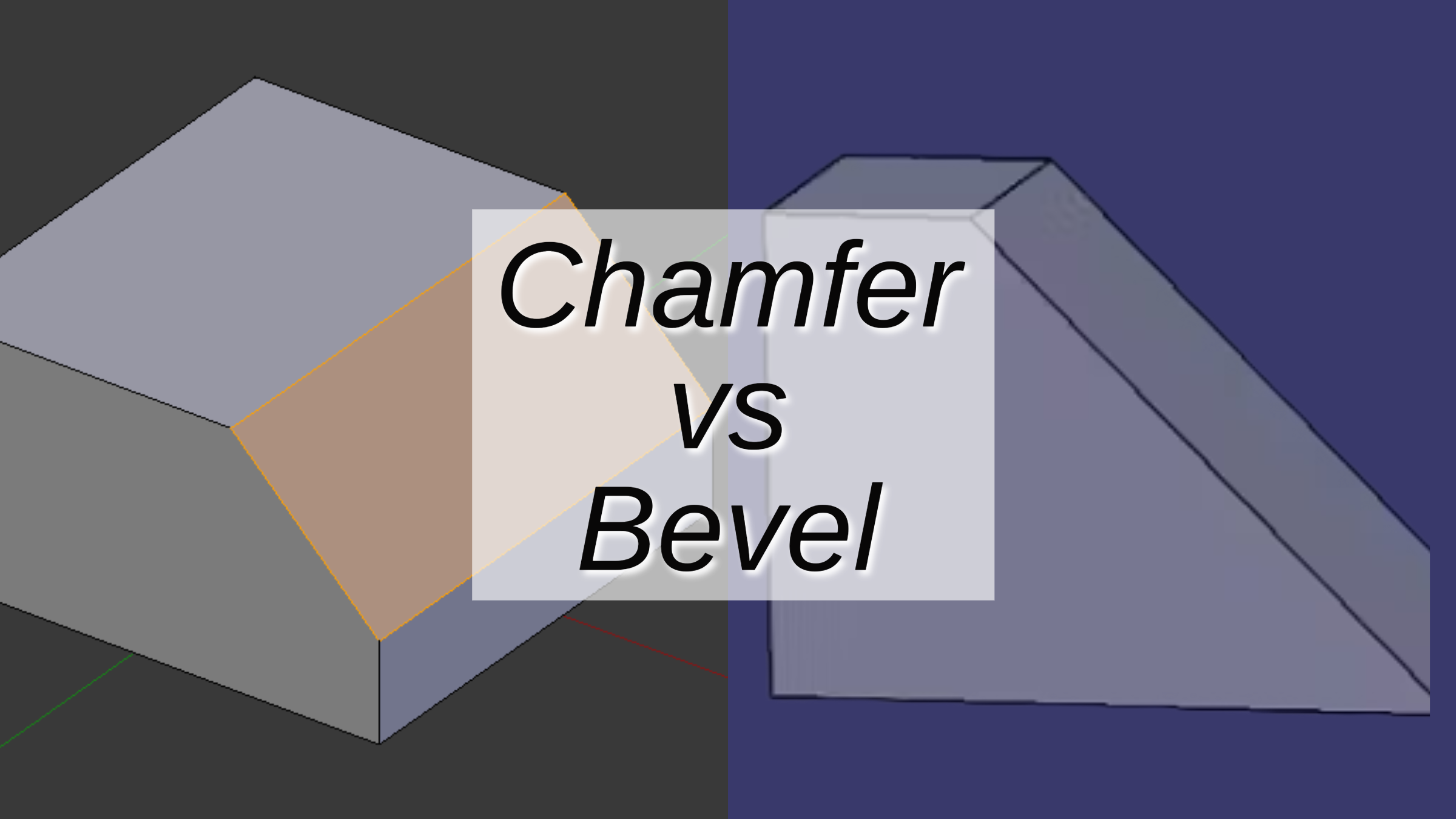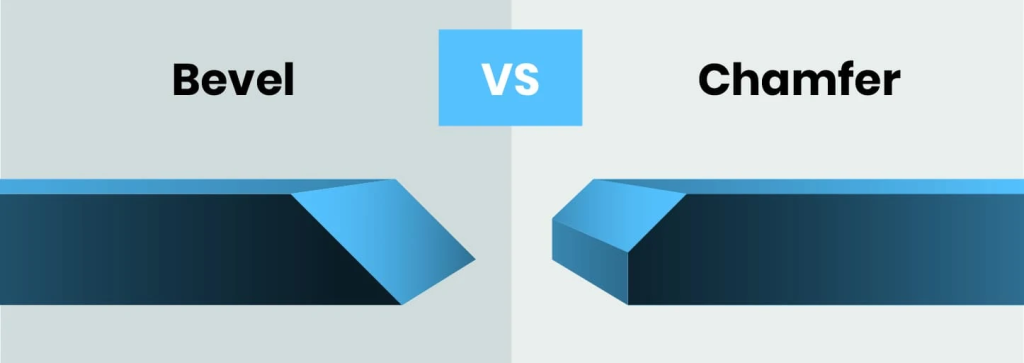Chamfer vs Bevel: Understanding the Differences and Applications

This article compares chamfer with bevel, explaining their distinctions and optimal usage in various industries.

Source: rmpproducts.co.uk
Introduction
In design and manufacturing, "chamfer" and "bevel" refer to edge modifications that are crucial in various fields like machining, carpentry, 3D printing, and metalworking.
Though they serve similar purposes, they have distinct characteristics and applications. This article explores the differences and practical uses of chamfers and bevels.
Chamfer vs Bevel Edge: What are They
Definition of Chamfer
- Transitional edge: A chamfer creates a smooth transition between two faces of an object, helping to eliminate sharp edges.
- Flat, angled cut: Typically cut at a 45-degree angle, chamfers are made using tools like chamfer mills or files.
- Functional purposes: Chamfers are commonly used in mechanical parts to prevent injury from sharp edges and to facilitate easier assembly by allowing parts to fit together more smoothly.
- Examples: Common in carpentry to remove splinters from wood edges or in machinery parts to facilitate assembly.
Definition of Bevel
- Sloped edge: A bevel edge slopes relative to the material's surface, creating a more gradual transition than a chamfer.
- Variety of angles: Unlike chamfers, bevels can be cut at various angles, often customized for specific needs.
- Aesthetic and functional uses: Bevels enhance the visual appeal of objects, increase the bonding surface in joints, and prepare metal edges for welding by providing an optimal angle for the weld bead.
- Examples: Often found in picture frames for decorative purposes or in structural steel for welding preparation.
Differentiating Characteristics
- Angle: Chamfers typically have a fixed angle (often 45 degrees), while bevels can be cut at any angle.
- Purpose: Chamfers are primarily functional, designed to eliminate sharp edges and ease assembly. Bevels serve both functional and aesthetic purposes, often used in design and to enhance the strength of joints.
- Appearance: Chamfers are usually straight cuts, whereas bevels can create a more gradual transition between surfaces.
Chamfer vs. Bevel: Analyzing Distinctions
Geometric Differences and Effects
Edge Alteration
Chamfers create a flat edge.
Bevels create an angled, sloping edge.
Mechanical Properties and Stress Distribution
Chamfered edges distribute stress more evenly, reducing the likelihood of stress concentration.
Beveled edges increase the bonding area for adhesives or welding.
Implications for Functionality and Design
Functionality
Chamfers are commonly used in mechanical parts where precise fit and safety are crucial.
Bevels are often utilized in decorative elements or where strong, seamless joints are needed, such as in carpentry or metalwork.
Aesthetic Appeal
Chamfers provide a clean, precise look ideal for technical and safety-critical applications.
Bevels add an elegant, smooth transition, enhancing the visual appeal in decorative and structural applications.
Visualizations Highlighting Variances
Diagrams and Visual Aids
Illustrations showing the angles and transitions of chamfers and bevels.
Diagrams can clarify how each edge modification affects the mechanical and aesthetic aspects of the final product.
Chamfer vs. Bevel: How to Identify
Chamfer
Chamfers are characterized by a flat, angled cut at the edge of a material.
Typically, chamfers have a consistent angle, often set at 45 degrees, though variations can occur based on specific design requirements.
These flat edges create a distinct transition between surfaces, providing both functional benefits and aesthetic appeal.
Bevel
Bevels, on the other hand, feature a sloping edge that may vary in angle.
Unlike chamfers, which create a flat transition, bevels produce a gradual slope from one surface to another.
The angle of a bevel can vary widely, depending on the intended purpose and design specifications, ranging from subtle slopes to more pronounced angles.
Chamfer vs. Bevel: Pros and Cons
The table below provides a concise overview of the pros and cons of chamfers and bevels, highlighting their advantages and limitations in various aspects.
| Advantages | Limitations | |
|---|---|---|
| Chamfers | 1. Safety | 1. Limited angles |
| 2. Easy assembly | 2. Primarily functional | |
| 3. Stress distribution | ||
| Bevels | 1. Increased bonding area | 1. Complexity in manufacturing |
| 2. Versatile angles | 2. Potential material waste | |
| 3. Aesthetic enhancement |
Benefits of Chamfers and Bevels
Chamfers can significantly reduce the risk of injury and improve the ease of assembly, particularly in mechanical parts where safety is paramount.
Bevels contribute to the creation of stronger joints and introduce an aesthetically pleasing element to designs, enhancing their overall appeal.
Challenges and Potential Drawbacks
The main challenge with chamfers lies in their limited angle options, which may not always be suitable for all applications.
Bevels, while offering versatility, can be more challenging to produce accurately and may require additional material and time during manufacturing.
Strategies for Mitigating Limitations
Choosing the appropriate tool and technique for cutting chamfers and bevels is crucial in overcoming their limitations.
CNC machines and specialized cutting tools excel in achieving precise angles and edges, whether chamfered or beveled, thus mitigating challenges associated with their manufacturing process.
Chamfer vs. Bevel: Which to Use
Geometric Considerations
Chamfers
Ideal for applications requiring a precise, flat edge, such as in the aerospace industry for aerodynamic components.
For instance, chamfers are commonly used in the automotive sector for engine components where a smooth transition between surfaces is crucial for efficient airflow.
Bevels
Better suited for creating larger surface areas or smoother transitions, seen in woodworking for furniture manufacturing.
For example, in carpentry, bevels are often employed in creating joints for furniture pieces like tables and chairs, providing both strength and aesthetic appeal.
Functional Requirements
Chamfers
Preferred for safety and ease of assembly, especially in mechanical parts like gears in machinery.
Studies have shown that chamfers on gear teeth reduce stress concentration, leading to longer component life and improved reliability.
Bevels
Offer increased bonding area for joints, promoting stronger connections, as evidenced in metal fabrication for welding.
Research indicates that beveled edges in welded structures exhibit higher fatigue strength and resistance to crack propagation, critical for structural integrity.
Aesthetic Preferences
Chamfers
Primarily functional in nature, with a focus on safety and precision, commonly found in electronic devices for component housing.
For instance, smartphones often feature chamfered edges on their aluminum frames, providing both durability and a sleek appearance.
Bevels
Provide a more elegant and smooth appearance, making them ideal for decorative purposes, such as architectural detailing.
Historical architectural landmarks often showcase intricate beveled edges on pillars and cornices, adding visual interest and sophistication to the design.
In summary, the decision between chamfers and bevels hinges on their distinct advantages: chamfers excel in precision and safety, beneficial for applications like aerospace components, while bevels offer versatility and aesthetic appeal, particularly in woodworking and architectural detailing.
Understanding these differences allows for informed decision-making tailored to specific project needs.
Conclusion
Both chamfers and bevels play essential roles in design and manufacturing, each with unique characteristics that cater to different needs.
Understanding the differences between these edge modifications helps in choosing the right technique for any given application.
Choose the Best Solution at Unionfab
At Unionfab, we offer advanced manufacturing solutions tailored to your specific requirements. We offer various services such as CNC Machining, as mentioned in this article.
For further details, please feel free to reach out to us via our Contact Us page.


